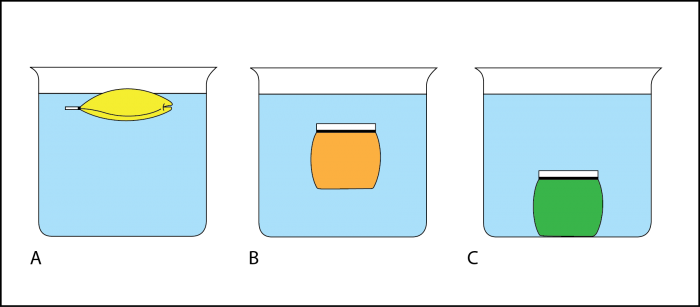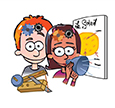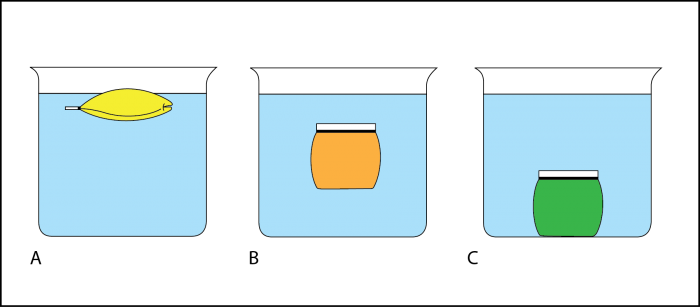
Liquid Density
- Accueil
- >
- Tous les SAÉ
- >
- Liquid Density


Liquid Density
Question

Why do some liquids sink to the bottom and some float to the top? How does each liquid stay separated in the beaker and why?
Initial Ideas
By looking at the liquids presented infront of you, draw or write your predictions in terms of which liquid will sink to the bottom and float to the top.
Why do you think so?
Now that you have felt the texture of the liquids, have your predictions changed? If so, draw your new predictions and explain why.
Plan
 Image...
Image...Materials
- Glass cylinder
- Water (1/4)
- Vegetable oil (1/4)
- Dish soap (1/4)
- Rubbing alcohol (1/4)
- Melted honey (1/4)
- Blue food coloring (1 tbs)
- Red food coloring ( 1 tbs)
- 5 bowls
- 1 spoon
- Apron
- Copy of the handouts
- Pencil and colours
Procedure
1. Measure 1/4 a cup of each liquids into and seperate in different cups.
2. Pour the honey in the center of the glass cylinder and let it sit for 30 seconds
3. Pour the dish soap in the center and let sit for 30 seconds
4. Add red food coloring to the water and mix. Pour the water while tilting the glass cylinder and let sit for 30 seconds.
5. Pour the vegetable oil while tilting the glass cylinder and let sit for 30 seconds.
6. Add blue food coloring to the rubbing alcohol and mix it. Pour the rubbing alcohol while tilting the glass cylinder and let sit for 30 seconds.
Investigation
Draw a picture of what your glass cylinder looks like with labels of the liquids.
Were your predictions correct? If not, what was wrong?
Explaination
Claim (this answers our investigation question)
I think...
Evidence (this is the data from our investigation that supports our claim)
I think this because I have seen or done?
Evidence 1:
Evidence 2:
Evidence 3:
Reasoning (this is the scientific idea that helps us explain why our data counts as evidence)
The science idea or principle that helps me explain this is:
Applying your knowledge : what would happen if?
1) We added soda to the glass cylinder?
2) We did not tilt the glass to pour some of the liquids?
 Image...
Image...
 Image...
Image...| Cr1 Description adéquate du problème. Une hypothèse doit inclure une justification | Formulation d'une explication ou d'une solution provisoire |  |
 Image...
Image...
Liquid Density
-
-
The estimated time for this lesson is 60 minutes.
-
Phenomenon: Student will be shown a picture of a bowl of water and oil that remain seperated from one another.
Driving Question:
Why do some liquids sink to the bottom and some float to the top?
How does each liquid stay separated in the beaker and why?
-
CLAIM
- I think that in order for each liquid to stay separate in the beaker, the liquids being combined need to have different densities (in other words, some liquids will need to be heavier and others will need to be lighter than the subsequent).
EVIDENCE
I think this because:
- I have noticed that when physical objects are deposited in a liquid, the heavier objects sink to the bottom and the lighter objects float to the top (near the surface of the beaker).
- I have also noticed that when I add two liquids that have similar densities together, these mix, rather than separate, because they have the same mass/volume.
- Lastly, through the method of trial and error, I came to the realization that no matter the order in which I layer the liquids in the beaker, based on the densities of each of these solutions being added, the same separation occurs nonetheless (the same, heavy liquids sink to the bottom of the beaker, and the same lighter-density liquids sit near the top of the beaker).
REASONING
The science principle that helps me explain this is:
- If mass is a measure of how much ?stuff? there is in an object or liquid, density is a measure of how tightly that ?stuff? is packed together. In other words, if the weight (or mass) of something increases, but the volume remains the same, then the density also rises.
- This helps me use my evidence to support my claim because if the weight and/or mass of all the liquids that were combined in the beaker had been the same, these would have mixed together instead of being layered in a way where we can clearly see the different solutions.
-
- The students will know the difference between heavy and light objects when they pick them up. Some may even be able to make the distinction solely based on looking at the objects, due to prior experience handling such objects.
- The students will know what most, if not all of the liquids that they will be conducting the experiment with.
- They will be familiar with the term ?density,? ?beaker,? ?weight,? ?mass,? and ?volume.?
- Students may think that the order in which we add the liquids to the beaker matters.
- Their predictions may change after having completed their task on ?Initial Ideas,? where they are asked to predict which liquids will be layered in which order by a) observing the liquids only and b) then feeling the textures using a spoon.
Other non-normative ideas could include:
- Objects float on water because the water pushes up on it
- Heavy objects always sink and light objects always float
- Objects that have holes in them always sink (some express that this is true, but that there is an exception- a sponge)
- A small object definitely has less density that a larger object and vice versa.
- Density = Thickness
- Oil weighs less than water
- If you take an object, such as a ball of clay and add more clay to it, because the ball is now lager, the density then also increases.
- Students may also come to think that the food coloring that we use and add to the liquids affects the density of these.
- Some may assume that the specific color itself has more mass than another (for example, a student might say, ?Well maybe it's because we added red coloring instead of yellow that it sunk to the bottom. I think we should try and see what happens if we use another color?).
-
Instructor: Students:
- Picture of water and oil -Glass Cylinder
- Notebook to jot down the students' answers -Water (1/4)
- Cue cards with questions to ask students -Vegetable oil (1/4)
- Blackboard to post students' models -Dish soap (1/4)
- Beaker with final product (example model) -Rubbing alcohol (1/4)
- Tape -Honey (1/4)
- Intructions for lab for students -Blue food coloring (1 tbs)
-Red food coloring ( 1 tbs)
-Five bowls
-One spoon
-Apron
-Copy of the handouts
-Pencil and colours
-
La matière:
- L'élève devrait bien comprendre comment classer des objets à l'aide de leurs propriétés. (couleur, odeur)
- Décrire la forme, la couleur et la texture d'un objet d'une substance
- Reconnaître des mélanges dans son milieu (alcool, miel, l'eau etc.)
- Distinguer un mélange de liquides miscibles d'un mélange de liquides non miscibles
Transformation de la matière:
- Démontrer que des changements physiques ne modifient pas les propriétés de la matière
Langage approprié:
- Terminologie liée à la comprehension de l'univers matériel : Utiliser adéquatement la terminologie associée à l'univers matériel
-
Engage
Management considerations: Make sure students do not search up results on their phones and use their imagination and prior knowledge to come up with predictions.
The teacher will:
Introduce the lesson and set the challenge. Show a picture of a bowl with water and oil inside. Begin by asking the question: why do some liquids go to the bottom and some sink to the top? This will immediately strike ideas in their minds. During the start of this lesson, the teacher will allow students to team up in groups and discuss this question. Each group will have 10 minutes to discuss. The teacher will walk around and see what the students are discussing. The teacher will ask students to explain/restate their partner's reasoning and if they agree or disagree and why. This group discussion will help students learn each others thoughts and any prior knowledge they have on liquid density. After the discussion, students will be asked to draw what they think will happen when pouring five different liquids in one glass cylinder.
The students will:
Discuss with their classmates why they think some liquids sink to the bottom and some float to the top.
Listen to one another while sharing and exchanging ideas.
Exchange thoughts and ideas on liquids and what makes liquids sink or float and why.
Agree or disagree with their classmates while challenging their answers with their own examples/reasoning.
Make predictions by drawing a model on what liquids will sink or/and float in their glass cylinder using the liquids in class.
Use prior knowledge based on a past class on density to make predictions on results.
Explore
Management considerations: Make sure the students are following the steps correctly and tilting the glass correctly. While students are conducting the lab, take notes on every student and how they are doing. As a teacher, walk around the classroom and check on how every student is doing and if they are on the right track.
The teacher will:
Ask the studens to take out the supplies of the box. Measure each liquid properly and prepare all their supplies so that they are ready to begin pouring the liquids into the glass cylinder.
As the students work on this task, make sure that they see how the liquids separate from each other. Ask them questions such as : What do you see? Write down or draw what you see and label each liquid.
Circulate the classroom and ask students to explain their ideas and the teacher will revoice their ideas.
While circulating the classroom there will be some students not following the directions completely. As a teacher, you need to be aware of that. Some students will not tilt the glass cylinder and just pour the liquid directly. At this point, stop the students and ask them to re-read the procedure. Point out that the most important procedure to get effective results is to tilt the glass.
Also ask a student who did this error to be ready to share it with the class.
After the lab is finished, ask students to draw their final results. As well as asking them if their predictions were correct.
Prior to the end of the class, ask students to put away their materials and to clean the glass cylinder.
If there is time, allow for a class discussion on what their results were.
The students will:
Follow the procedures of the liquid density lab.
While conducting the experiment, observe what happens to each liquid and take notes. Students can also draw what they observe.
At the end on the lab, come up with an explaination as to why some liquids sink to the bottom and some liquids float to the top. Also include why liquids have this result.
Explain + Argue
Management considerations:
In this part of the lesson, the students should be able to explain and understand why the liquids sink or float. Their claims should be backed up with the evidence that the less dense liquids will float, and that the liquids with more density will sink to the bottom. They will then understand the phenomenon by constructing their own knowledge. This is when the teacher will guide the conversations with talk moves.
The teacher will:
Engage the class in conversations by writing on the board the reasons for each liquid floating or sinking. The teacher will post on the blackboard the students' final product model and ask students to point of the differences and similarities in each model. The teacher will start a discussion by asking students what evidence supports their claims. The teacher should engage the students by repeating, asking questions and clarifying what the students want to say. To close the discussion, the teacher will tie the material learned on density during the previous class and liquid density by making connections between the results of this lab and the scientific principle of density. The teacher will ask if students have any more questions or concerns and finally, thank them for their efforts and participation in this activity.
The students will:
Organize their thoughts on paper and present their findings to the class. They will be divided into groups of 2-3. They will discuss with eachother what liquids sank and which ones floated, in the specific order. They should be identifying patterns and trends in the data while listening to other's opinions. Students should be attentive and will be respectful of the other classmates findings.
Their information and data should be organized in meaningful ways. They should come up with diagrams and models that come to represent the desnsity of each liquid.
-
https://www.stevespanglerscience.com/lab/experiments/seven-layer-density-column/
https://us.corwin.com/sites/default/files/upm-binaries/59051_Teaching_HS_Science_excerpt.pdf
http://www.education.gouv.qc.ca/fileadmin/site_web/documents/education/jeunes/pfeq/PDA_PFEQ_science-technologie-primaire_2009.pdf
